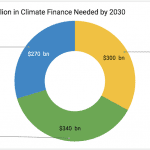Airtime to the Rescue: Why India Should Mobilize Telcos for Disaster Relief
Last April, when a 7.8 magnitude earthquake shook Nepal, amid the human tragedy something interesting happened from the standpoint of mobile financial services. Telcos like Airtel, BSNL and a few others offered free mobile airtime for 48 hours to their customers based in India, so they could connect with their family members and friends in Nepal. Similarly, in December 2015, when severe floods hit the south Indian state of Tamil Nadu, telcos once again swung into action – this time joined by Indian payments bank licensees. State-owned BSNL offered not just free airtime but also 100Mb of data and SMS services free of charge for one week. Similar offers were rolled out by Airtel and Paytm, both of which had been granted payment bank licenses earlier in the year.
These examples show how India, a country of 1.2 billion people, is rebooting itself digitally, with the country’s banking system leading the charge. They also illustrate the potential of utilizing the payments infrastructure to respond to natural disasters. I believe this potential could be more fully realized through a new kind of entity, which I’ll term Emergency Payments Network Operators (EPNOs). EPNOs could be temporary, on-tap “no frills alternate payments systems” used to channel relief and rehabilitation funds to victims in a cost-effective, transparent and timely manner, when a calamity strikes. This post explores the reasons India is the ideal proving ground for the concept.
Why India?
In the past, there have been pilots for similar programs in places like Haiti, where the Gates Foundation-supported Haiti Mobile Money Initiative was rolled out in the aftermath of the 2010 earthquake. But India would be even more fertile ground for this sort of approach, since unlike Haiti or other infrastructure-deficient countries, India has the very rich India Stack, a set of open APIs that enable the integration of authenticated mobile applications with data that’s securely stored and provided by the government. This data includes universal and robust identity, authentication and payments infrastructures like the Unique Identification Authority of India (which issues a 12-digit “Aadhaar” identity number to all citizens), the National Payments Corporation of India and the recently launched Unified Payment Interface, among others. These are coupled with front-end instruments and delivery channels like prepaid payment instruments, digital wallets, payments banks, business correspondents, common service centers, etc. Combined with India’s over 1 billion mobile telecom subscribers, these financial access-boosting measures could make the existence of EPNOs a very real possibility.
India’s Infrastructure Advantage
Although it may appear complicated, when all these dots are connected using the mobile, Aadhaar and payments infrastructure, and combined with banking and telecom regulations aligned with market needs during disasters and natural calamities, existing MNOs could be easily converted into EPNOs. Their airtime could be used as an acceptable digital currency at specific telco distribution and/or business correspondent/common service center points. In terms of verifying the identity of users, practically all the country’s mobile subscribers are KYC-verified customers, and over 90 percent of Indians have a functional Aadhaar number. So if mobile and Aadhaar numbers in India are mapped with unique users, just like the National Database and Registration Authority (NADRA) and Computerised National Identity Card (CNIC) have done in Pakistan, it could solve the identity verification issue in one stroke.
Pushing e-value from a telcos’ back end would be just like issuing regular airtime, which should not be a big task for telcos. The only missing elements would involve the government providing regulatory flexibility for telcos to play this role during extraordinary situations, and telcos themselves ensuring that they are business-ready, by incorporating an additional emergency banking service into their platform which, just like any other value-added service, could be activated for a limited time from the back end when need arises.
An Idea Whose Time Has Come
The transfer of airtime during natural disasters in itself is not a new idea. In fact, the role of telecom networks in risk sharing during natural calamities has been extensively studied in Rwanda. But in India, the concept could come to full fruition. The underlying potential of the existing mobile infrastructure to be used as a low-cost, transparent and efficient channel in transferring monetary value, combined with the country’s credible online identity, authentication and payments infrastructure, could make India the ideal candidate to leverage the power of mobile money in disaster-hit regions.
Photo credit: United Nations Development Programme, via Flickr.
Disclaimer: Jatinder Handoo is AVP of Financial Inclusion Advocacy & Strategic Alliances at Microfinance Institutions Network (MFIN). All views expressed in this post are personal, and MFIN does not necessarily subscribe to them. Jatinder can be contacted on Twitter at @jatinhandoo.
- Categories
- Uncategorized



